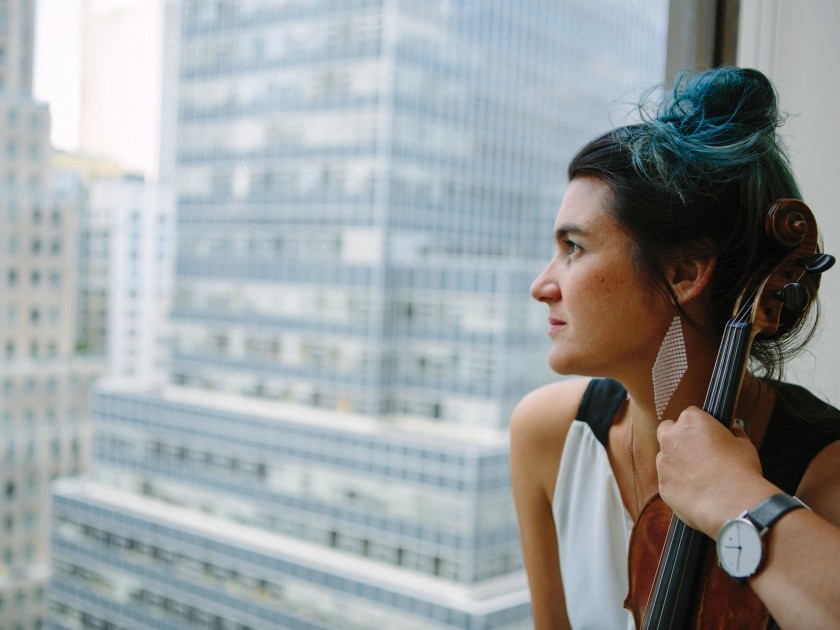
Photo: Alicia J. Rose
In my own way, I was a fundamentalist, worshipping at the altar of art.
I began playing a tiny violin when I was three, after my mother saw a Phil Donahue special about the Suzuki method. Throughout my teenage years I spent my Saturday mornings at the local music conservatory, as a religious girl would have gone to shul–not out of obligation or ambition, but out of love.
I didn’t grow up surrounded by Jewish texts, but I was surrounded by books, and I wanted to be a writer since I could hold a pen. I loved series, the epics of my childhood: Little House on the Prairie, Anne of Green Gables, and Earth’s Children. In the plucky, flawed heroines I saw myself; and by reading about their struggles and desires, I began to understand my own.
At seventeen, I took my violin and moved to New York City to study creative writing in college. In the late nineties, there was a free broadsheet that listed every single reading in the city; I taped it to my wall and took the subway to literary events night after night. I stayed up late having pretentious arguments with my poet friends. I also played in a string quartet, learned about music composition, improvised scores for dancers, and wrote songs.
In class, I encountered the Odyssey, my first real epic. I was captivated by its mysterious scale: replete with gods, but also fundamentally human. Despite my best efforts to read with academic detachment, I experienced this classic of Western civilization much as I had Anne of Avonlea: I searched for reflections of my inner life and found them there, writ large.
As I read, I performed a sort of translation. When the Sirens called to Odysseus, I thought of my high school eating disorder, the dangerous seduction of thinness. When Penelope tested Odysseus upon his return, I understood that she was asking him, “Do you truly see me?” When Odysseus responded with the secret of their marriage bed, I knew he was saying, “Yes, I do,” and hoped to find that sort of love one day.
Then I took a class on James Joyce’s Ulysses, and felt a shock of validation. Joyce wrote the way I read (except, l’havdil, he was a genius). He translated Odysseus’ wanderings into a single day in the life of Leopold Bloom, a Jewish Dubliner, a regular person experiencing the small but profound tragedies and mundanities of modern life. Bloom is Odysseus, just as I was Laura, Anne, Penelope.
—
When I was eight, I asked my parents if I could have a bat mitzvah. We were standing in the sunny kitchen. They looked at me, looked at each other, raised their eyebrows in unison, and looked back at me. My mom sighed. “Yeah,” she said, “It’s probably time you started going to Hebrew school.”
After my bat mitzvah, I didn’t think much about Judaism for several years. But in college, I began to wonder about the texts that lay behind the Judaism that had made its way down to me like a cup of weak but sacred tea. I wanted to experience these texts undiluted, in the original Hebrew. A friend told me about a yeshiva in Jerusalem called Pardes; I applied for a scholarship and patched together a loan, and one month after graduation I was on a plane to Israel. That’s how I finally came to the ultimate odyssey, the epic about which I would make art for years to come: the Torah.
At Pardes, I was gratified to find that I was welcome, even encouraged, to read with my heart as well as my mind. And with the devotion I knew from years of violin practice, I dove into ten, eleven, twelve hours a day of study in the beit midrash. Before long, my mind was full of Torah. Fragments of wisdom, worn smooth as stones from having been passed down orally for generations. Secret names for God and words that added up to numbers that signified other words. And stories of surprisingly determined women who used all the resources at their disposal— voices, outfits, sometimes weapons — to get what they needed.
After a couple of years, I returned home. When I opened up my laptop to write a song, Torah suddenly began to weave itself into my work.
Writing about a first date in a Brooklyn bar, and thinking of the mystics who believed the aleph-bet to be the building blocks of the world, I found myself describing Hebrew letters hovering in the air around us. When that boyfriend became my husband, I composed a love song in the voice of Ruth. Healing from my son’s birth by C‑section, I wrote a poem invoking the kabbalistic understanding of the body as two halves: compassion and judgment.
—
There is a moment in Ulysses where Joyce riffs on connections between the Jews and the Irish. “What points of contact,” he asks, “existed between these languages and between the peoples who spoke them?
Point of contact. I can think of no better way to describe my process of creating contemporary work in conversation with an ancient epic. First I ask, What points of contact exist? And then I write from that place.
Alicia Jo Rabins is the author of Fruit Geode and the creator of Girls in Trouble, a musical project about the women of the Torah.